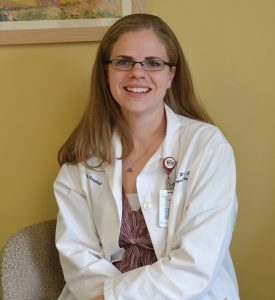PAs: The perfect bridge between medical and mental health
By John M. Trumbo
Tracy Keizer, PA-C, practices in the 100-bed adult psychiatry unit of the Regions Behavioral Health System in St. Paul, Minn. Regions is a safety-net hospital providing care for patients with limited or no access to healthcare because of financial circumstances, insurance status or health conditions. “The specific unit where I work focuses on mental illness and chemical dependency,” Keizer explains. “I see patients with co-occurring medical and psychiatric diagnoses, and work alongside a psychiatrist on a team.” She’s also in charge of the administrative duties of the PAs and NPs within her psychiatric services unit.

Keizer and her psychiatrist partner share responsibility for the 20 patient beds in their unit. She becomes the primary provider for the patients under her care, performing an intake and admission interview, managing their progress, planning follow-up appointments, and arranging for their eventual discharge. “I’m the one on the team making decisions about medications, referrals, family meetings, motivational intervening,” she says, “and if someone needs to be committed through the civil courts I initiate that process along with my supervising psychiatrist.”
In addition to her clinical practice, Keizer directs Regions’ psychiatric fellowship program—a 12-month, postgraduate course for PAs and NPs that began in 2008. She was a fellow herself before being asked to direct the program, which currently only accepts two fellows each year. “I get a lot of interest from PAs who have done primary care for 10 or 15 years and want to do a psychiatry fellowship because they realize how much of their practice involves mental health,” she says. “They’re coming to learn psycho-pharmacology, therapy, how to understand medication management and how to meet those needs in their primary care practices.”
Counting on your team
Keizer was taking premedical courses at Dordt College in Sioux Center, Iowa, when one of her classmates introduced her to the idea of becoming a PA. “When I started looking at PA schools and what a rich education they offered, I thought it would be a great role for me. And as I went through school, it was continually reinforced to me that [our] team-based approach is really going to be the answer to a lot of the [challenges] we have in healthcare, and the shortages we face, so I felt more and more convinced that this was the role for me.”
She adds, “I went into psychiatry because I think that the patient population is a fascinating one. It’s the idea of not being black and white; there’s no lab order [to determine] if somebody has schizophrenia. Learning about the mind is fascinating.”
Each morning, Keizer and her psychiatrist partner meet to discuss patient progress, and collaborate on medications, different approaches to therapy or methods of engaging with patients. Nursing staff, social workers and occupational therapists round out the psychiatry team. Keizer notes that the general medicine training she received in PA school helps her provide key clinical support to her team, including medication options and potentially dangerous drug interactions. “Having a PA on our team with a general medicine background who understands both [the clinical side as well as the specialty side] makes it easier, more efficient and is a good use of resources.”
Being able to count on the members of your team is equally vital, especially in situations with patients who are mentally unstable. “It’s knowing where your boundaries are, knowing your comfort level and being able to communicate well with your team. You have to feel confident—in yourself, in what you’re doing and in your team.”
Filling the gaps in healthcare
Keizer hopes that more PAs consider practicing in psychiatry, explaining that “there’s a huge need for more psychiatric providers in the mental health field—in big cities but also in rural areas. There are people waiting months and months to see a psychiatric provider. It’s a huge crisis, and I think PAs are a great way to fill this gap.”
She goes on to say, “Training PAs to feel more comfortable in the psychiatric setting is a great idea as well as getting psychiatrists more comfortable with a team-based approach [in order to] supervise more patients with the help of a PA. I think PAs are the perfect bridge between medical and mental health.”
Improving continuity of care
At Regions, Keizer has been working closely with the hospital medical director to begin providing seven-day care for psychiatric patients. “We are moving toward a model of having a psychiatrist and a PA work together on each unit to extend the services of each psychiatrist,” she says. “Having seven-day-a-week coverage at a psychiatric hospital is huge; it’s not something that’s done around the country, but we’re hoping that it catches on because it’s better for patient care, families appreciate it, providers are there all day long to answer calls, answer questions, and it will improve continuity [of care].”
She emphasizes the growing shortage of psychiatrists, which mirrors other areas of practice. “We do have quite a few psychiatrists in residency who then move onto subspecialty fields like child psychiatry or forensics or geriatric psychiatry and move out of general psychiatry. Also, many of them want to work in urban areas, and we just don’t have enough in rural areas. It’s very similar to primary care, which makes PAs in psychiatry [all the] more necessary.”
A passionate advocate for her profession as well as her area of practice, Keizer says, “Psychiatry has been the ugly stepsister of medicine and it’s time for that to stop. Psych patients are dying far too young because of their comorbid medical conditions. PAs, with our strong background in medicine, can treat both medical and psychiatric diagnoses. Our strong commitment to the physician-PA team is what makes this model work.”
John M. Trumbo is a writer/editor based in the Washington, D.C., metropolitan area.
Thank you for reading AAPA’s News Central
You have 2 articles left this month. Create a free account to read more stories, or become a member for more access to exclusive benefits! Already have an account? Log in.



